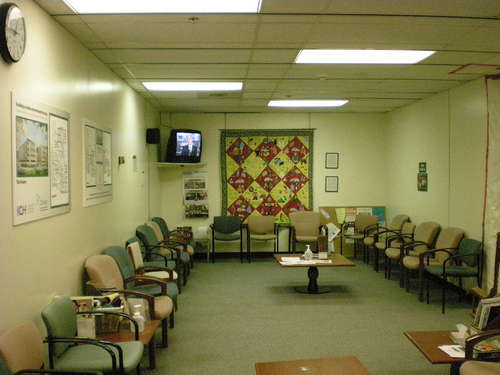



Creating an Empathic Environment

Parking .... the comfort of waiting room chairs ..... the cleanliness of the environment (carpets!) can have as much impact on patient satisfaction as the friendliness of the staff or the punctuality of the physician.
Waiting room time is also a significant factor in overall patient satisfaction[4]. Waiting room anxiety is a well documented phenomenon in pediatrics[5], surgery[5] and in the emergency room[3]. There are many techniques such as music and aromatherapy that have been used to decrease waiting room anxiety.
An empathic environment can improve both the patient’s and the physician satisfaction with the doctor-patient interaction. We feel better when our patients are comforted and accepting of our advice. Creating this environment can be tough but is useful to try to achieve as often as one can.
As a resident you may not be able to change your environment in the hospital, but there are things you can do to make the experience better for patients.
You are a part of the environment.
Respect your patient’s time. Try to be on time and if you are late, let them know.
Schedule appointments appropriately. Stagger your appointment times sensibly so many are not arriving at once. It is no longer acceptable to keep patients waiting for hours. Everyone’s time is important.
Dress professionally, especially when meeting patients for the first time. As a resident learner, you must inspire confidence. Better to dress up than down. Do not dress like your preceptor as they have already won the confidence of the patient and have nothing to prove. The right to dress casually is won over time when what one wears becomes less and less important to the patient.
Focus your attention on the patient, (for example - look people in the eye) as much as you can between note-taking or typing, especially at the beginning and the end of the interview.
Sit properly- reasonable posture, leaning slightly forward, looking interested, facing the patient.
Come up with a greeting, introduce and identify yourself- "Hello, Mrs. Gupta. My name is Dr. Jane Doe. I am a resident in family medicine and I will be interviewing you today before you see Dr. Henry".
Smile [2]
Even if it is a struggle to think positively of a patient, always speak of them in a positive way: this will influence your thinking positively. [2]
_________________________________
2. Wright SM, Hellmann DB, Ziegelstein RC. 52 precepts that medical trainees and physicians should consider regularly. American Journal of Medicine. 2005;118:435-438.
3. Holm L. Fitzmaurice L Emergency department waiting room stress: can music or aromatherapy improve anxiety scores? Pediatr Emerg Care. 2008;12:836-8.
4. Dansky K, Miles JA. Patient satisfaction with ambulatory healthcare services: Waiting time and filling time. Hospital & Health Services Administration. 1997;42:165-78
5. Vangoli L, Caprilli S, Robiglio A, Messeri A. Pediatrics. 2005;116(4):e563-7.
 Previous
Previous